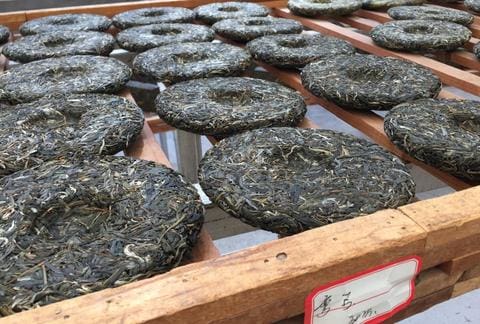
How to Store Pu Erh (And What to do about Aging It)
We’ve discussed some tea storage tips in the past (see tea storage 101 and tea storage 201), but we also noted how pu erh storage is a little different from the norm.

Whereas an airtight seal is important for your usual teas, this is not the best way to store your pu erh. Remember that pu erh tea undergoes fermentation during its production, and as a result, it is a special type of tea that is ready for aging, much like a good wine. This is why you will often find pu erh marketed and sold by its year and region of production (the year indicates its maturity and the region tells us something about its character).
So how do you store a pu erh tea? There are several things you need to take into consideration.
- Any tea, including pu erh, is sensitive to the surrounding environment.
You want to be vigilant with the odors near your tea. If you keep citrus fruit nearby, your tea can eventually absorb some of those citrus-like aromas. Ditto for garlic and onion, cleaning agents, car exhaust, flowers, and spices.
Does the area smell stale and damp? If so, your stored pu erh will eventually smell and taste the same way! Does it smell like pine or cedar? Don’t be surprised if your pu erh begins having a sharp, woodsy taste. Storing your pu erh in plastic? Guess what? Yep. Plastic flavor.
If you want your tea’s flavor profile to shine through, you really need to keep it away from these types of things while storing it and thoroughly check the storage area itself for strong, undesirable odors. Otherwise, you risk permanently affecting the taste of your tea!

- Humidity is a good thing.
We sometimes think that moisture is the enemy, and usually it is. We definitely do not want any moisture around our usual teas. But as we’ve said before, pu erh is just different. It’s ready and waiting for you to age it!
Without humidity, your pu erh will not age quickly enough, and yet it’s also true that we have to watch for moisture on the tea, as that can lead to mold growth and funny, undesirable flavors. This means that you want to store your pu erh in a humid area while still protecting it from water. To accomplish this, we recommend keeping it in a well-ventilated package or even an aging box.
If you want to get really technical, a hygrometer is an inexpensive device purchased from most home improvement stores that can tell you how much humidity is in the air. Pu erh aficionados recommend a room that averages 40-60% humidity.
Traditionally, puerh tea is stored in the form of tongs. One tong usually contains five or seven cakes wrapped in bamboo skin. This is our preferred method, if you want to store a puerh for aging or consume in later years.
- Some of the standard storage rules still apply.
It’s a big tea storage “no no” to expose your tea to any kind of sunlight. Sunlight increases the oxidation rate of your tea, effectively making it taste worse. This same rule applies to our pu erh as well! Whereas a green tea exposed to sunlight will showcase weak or stale flavor, a pu erh will instead taste increasingly bitter, destroying some of those oh so delicious fruity, complex notes we’ve come to enjoy.
Similarly, we also want to watch the temperature of the storage area. If it’s too cold, it slows the aging process, but if it’s too hot, we encourage the growth of the wrong microorganisms, giving our pu erh undesirable flavors, such as compost or, worse, worn socks. Yuck!
As it turns out, the ideal temperature is not too dissimilar from the ideal humidity levels. Idealy 50–70°F (20–28°C).
So how long should you age a pu erh?
That kind of depends on what you’re looking for. It can be enjoyed right now, but with each year and proper storage, new flavors will blossom forth, becoming sweeter and more complex over time. Some will say 5 years is a good number, but others will argue 10, 15, and even 20 years or more! This is just part and parcel of the wild world of pu erh tea, and it invites so much playfulness and experimentation, more so than any other kind of tea.
For the final entry in this series of post, we’ll be sure to discuss next week a few of the things to think about and look for whenever you purchase a pu erh. There’s also some good equipment to add to your collection!
